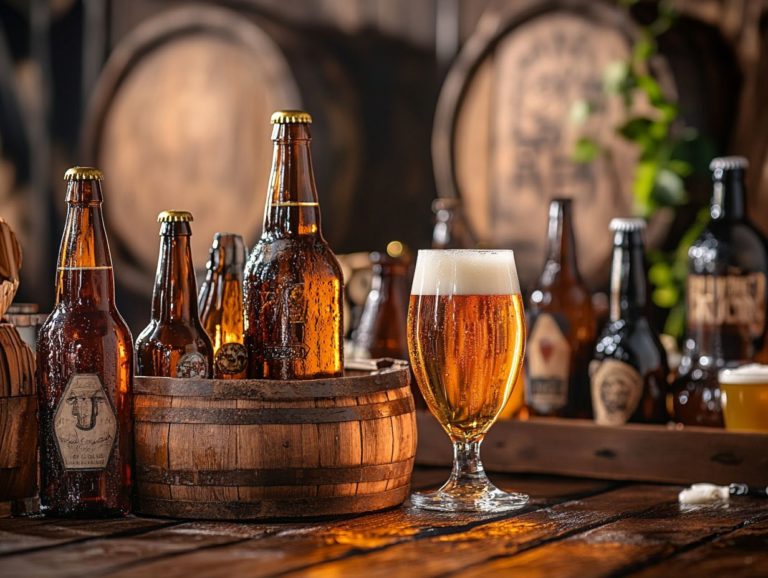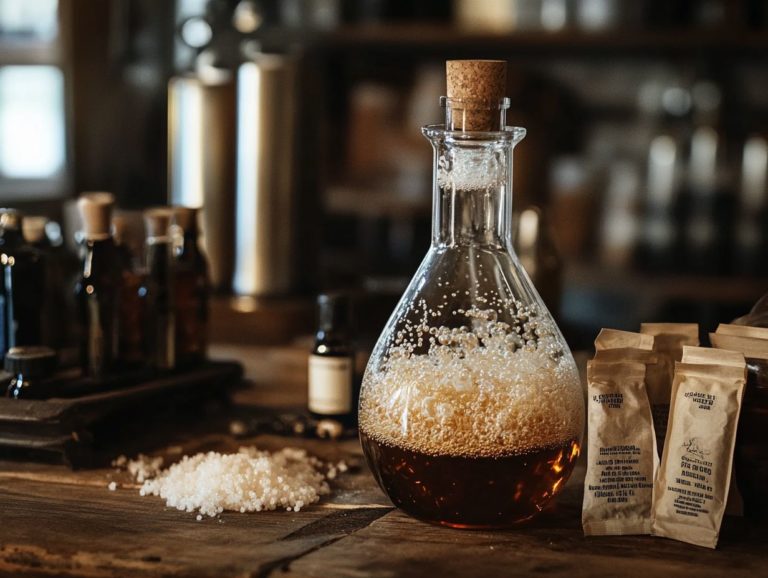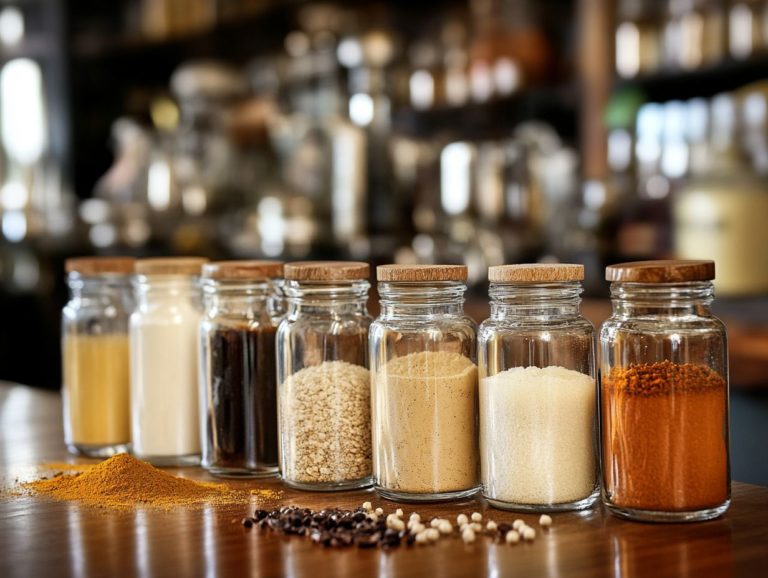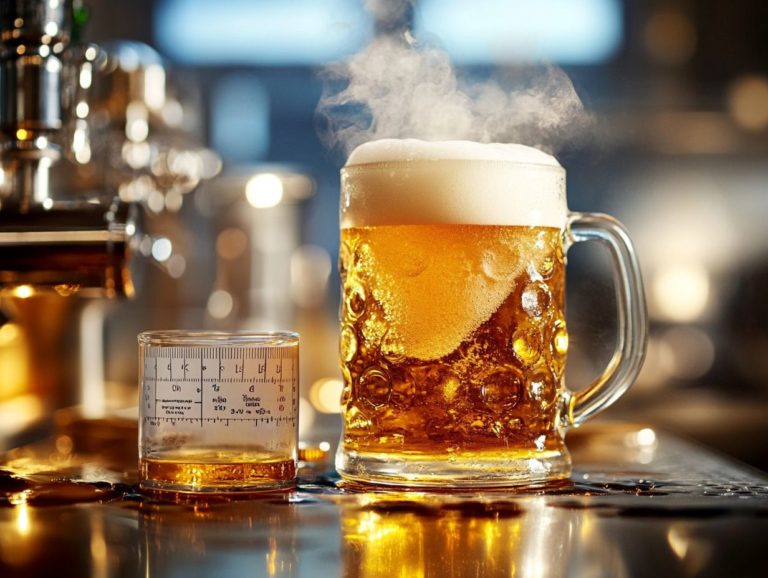Troubleshooting Beer Clarity Problems
Achieving that pristine beer clarity can be quite the challenge, regardless of whether you re a seasoned pro or just embarking on your home brewing journey.
This article delves into the common causes behind clarity issues, such as haze-inducing proteins and yeast lurking in suspension. By honing in on visual cues and conducting lab tests, you ll be equipped to identify these pesky problems.
You ll also discover effective prevention strategies and practical solutions to address any clarity concerns, ensuring that your brew not only tastes fantastic but also dazzles the eye.
Let s tackle the clarity challenge head-on!
Contents
Key Takeaways:

- Proper cleaning and sanitation are crucial in preventing beer clarity problems.
- Cold crashing, fining agents, and filtration are effective methods to fix beer clarity issues.
- Proper wort boiling and fermentation techniques can prevent haze-causing proteins and yeast from staying in suspension.
What Causes Beer Clarity Problems?
Beer clarity problems can arise from various factors during brewing. Often, haze-causing proteins interact with yeast cells, resulting in protein haze and chill haze.
The brewing techniques you use and the quality of your ingredients are crucial for clarity. For instance, using high-quality brewing liquor and managing the fermentation process effectively can help mitigate clarity issues.
Conversely, neglecting these important aspects can lead to that unwelcome cloudiness in your beer that you re always aiming to avoid.
1. Haze-causing Proteins and Chill Haze
Haze-causing proteins are among the main causes of clarity problems in beer, often resulting in an unappealing appearance that can compromise the brewing quality.
These proteins typically stem from the malt and yeast used during the brewing process, and when they interact with polyphenols from hops, haze formation occurs. The presence of these proteins not only diminishes the visual allure of your finished product but also has the potential to alter the flavor, as certain proteins tend to bind with flavor compounds.
To address these concerns, brewers like you can utilize various filtration techniques, such as crossflow or depth filtration, which effectively eliminate unwanted particles. Additionally, employing fining agents like isinglass, gelatin, or Polyclar can assist in precipitating these proteins, clarifying the beer and ultimately enhancing its visual appeal and overall quality.
2. Yeast in Suspension
Yeast in suspension can certainly present clarity challenges in your beer, especially if those yeast cells don t settle down properly during fermentation. This can lead to hazy beer, which can detract from the visual allure of your final product.
Once primary fermentation wraps up, any remaining yeast cells can continue to ferment in a secondary phase, complicating clarity even further if not managed properly. Sediment settling is critical for achieving a crystal clear beer; employing techniques like cold crashing can expedite this process, allowing yeast and other particulates to drop out of suspension more efficiently.
Opting for specific yeast strains, such as Wyeast 1098, can enhance flocculent properties, making for better sedimentation. By grasping the dynamics of yeast and their impact on clarity, you can implement effective strategies to produce a visually stunning beer that stands out in every glass.
3. Oxidation
Oxidation is a crucial concern that can impact the clarity of your beers. It often results in off-flavors and unwelcome cloudiness. This process unfolds when oxygen interacts with the compounds in the beer, triggering various chemical reactions that can create stale or cardboard-like flavors.
As you navigate through the brewing process, it s essential to take great care during several stages to minimize oxygen exposure. For example, employing proper kegging techniques ensures that the beer is transferred with minimal disturbance, effectively preventing oxygen from mingling in. You can also utilize carbon filtration systems to eliminate contaminants without introducing air. Strategies such as purging containers with carbon dioxide can significantly reduce oxygen levels.
By thoughtfully controlling the brewing and storage environment, you can maintain the desired clarity and flavor profile of your beer, ultimately elevating the overall quality of the final product.
4. Chill Haze
Chill haze can be quite the nuisance when brewing beer, creating those pesky clarity issues that you definitely want to avoid if you’re aiming for that crystal-clear finish.
This phenomenon occurs when proteins, which are natural compounds found in plants, and other compounds mingle in your brew, leading to a haze as temperatures dip. Fight back against this annoyance with these powerful techniques!
One tried-and-true technique involves adding fining agents like protofloc a natural clarifying agent derived from seaweed Irish moss, or Camden tablets during the boil. These agents work their magic by coagulating and settling proteins, which helps to significantly reduce the likelihood of haze forming. You can also introduce gelatin after fermentation to achieve even greater clarity.
By incorporating these techniques into your brewing routine, you can enhance both the stability and appearance of your final product, ensuring your consumers enjoy a superior drinking experience.
How to Identify Beer Clarity Problems?
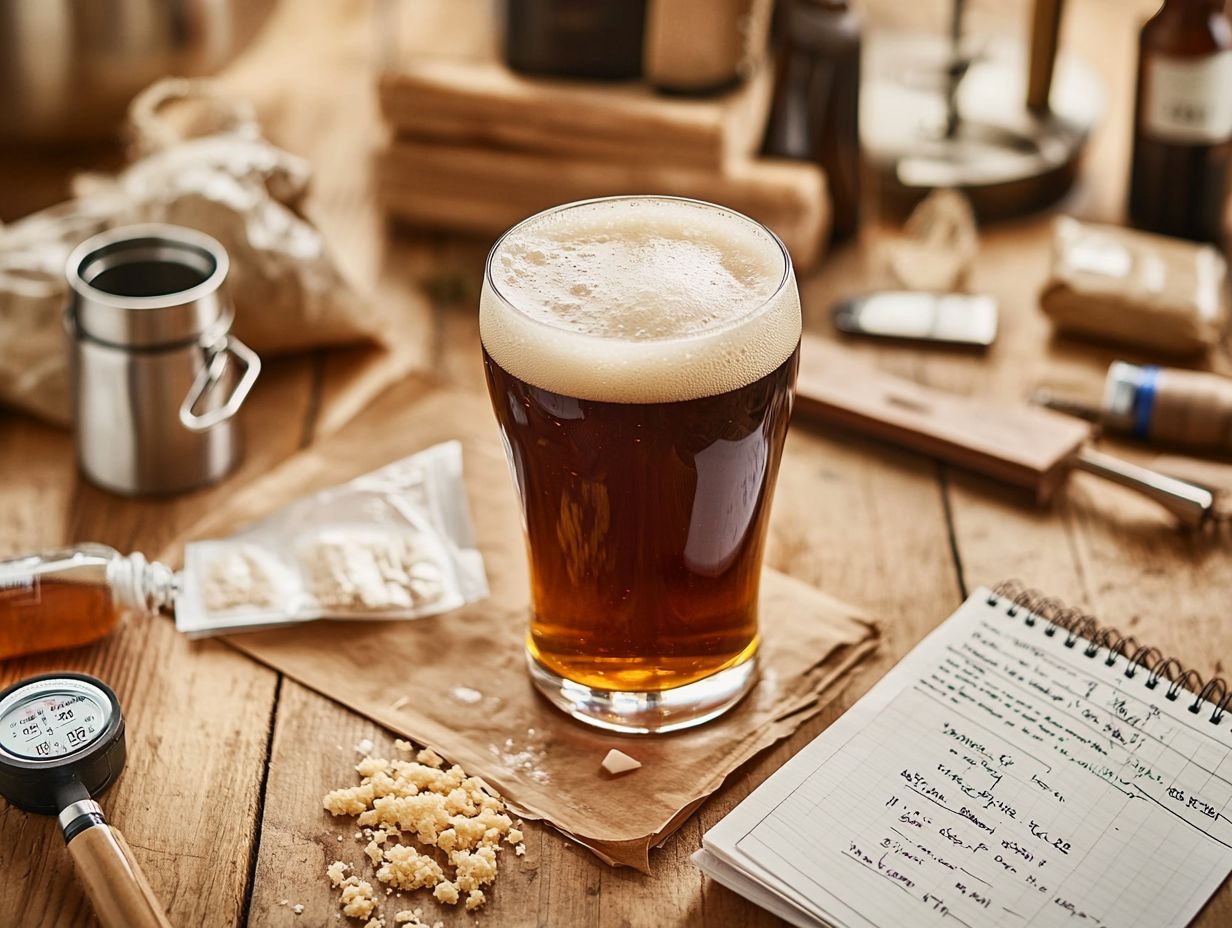
Identifying beer clarity problems is essential for any brewer striving to create a polished and visually appealing final product. Start by examining the beer’s visual appearance; look for any haze or cloudiness that may signal clarity issues.
Don t overlook the aroma and flavor profiles either, as certain off-flavors can hint at underlying brewing problems, often linked to haze-causing proteins or oxidation. For a more comprehensive analysis, consider conducting lab tests to quantify the presence of specific compounds associated with clarity issues.
This approach helps you troubleshoot effectively and refine your brewing process to achieve that perfect clarity.
1. Visual Appearance
The visual appearance of beer is your first clue to any clarity issues brewers often seek out cloudiness that can detract from its overall aesthetic charm.
A well-crafted brew should radiate a certain luminosity, showcasing vibrant colors that tantalize the senses and hint at the flavors within. Paying attention to the beer’s hue, whether it s a pale yellow or a deep amber, offers valuable insights into the ingredients and brewing techniques employed in its creation.
Assessing haze is essential; a perfectly clear beer indicates successful fermentation and filtration, while excessive haze might raise red flags about yeast or sanitation problems. For many in the brewing community, these visual cues are invaluable, enhancing the drinking experience while also serving as critical checkpoints for spotting brewing inconsistencies before they escalate into larger brewing challenges.
Now that you’re equipped with these insights and techniques, go ahead and experiment with them in your brewing process. Your quest for the perfect beer clarity starts now!
2. Aroma and Flavor
Aroma and flavor can provide valuable insights into clarity issues, as certain off-putting scents or tastes may signal brewing problems such as oxidation or insufficient fermentation.
For instance, if you encounter a beer with a sharp, sherry-like aroma or a flavor that brings cardboard to mind, it s often a sign of oxidation, which can lead to cloudiness in beer and compromise clarity. Similarly, off-flavors like sourness might indicate bacterial contamination during fermentation, further affecting the clarity of beers.
It s crucial to assess these sensory characteristics holistically; a beer with a muddled scent profile will likely also display visual haze. By identifying these red flags, you can pinpoint specific stages in the brewing process where brewing issues may occur, enabling you to make the necessary adjustments for improvement.
1. Proper Cleaning and Sanitation
Proper cleaning and sanitation are paramount in avoiding clarity issues, as even the smallest residues can lead to significant brewing challenges.
You should fully grasp the importance of establishing a rigorous cleaning and sanitation regimen throughout the brewing process to preserve the quality of your beer. This means not just focusing on the fermentation vessels and kegs, but also ensuring that all your tools, hoses, and taps are devoid of bacteria or any lingering substances.
Employing specific cleaning agents designed for brewing equipment such as caustic cleaners and acid rinses can effectively tackle even the most stubborn residues. Regular inspections and the use of hot water for sanitizing can make a substantial difference in maintaining a cleaner brewing environment and preventing cloudiness in beer.
By adhering to these practices, you can keep your brewing equipment in pristine condition, ultimately resulting in a higher quality product.
3. Lab Tests
Conducting lab tests is an invaluable strategy for you as a brewer to identify clarity issues and ensure the exceptional quality of your beer.
These tests can encompass turbidity assessments (which measure cloudiness), pH measurements (indicating acidity), and yeast viability checks (assessing yeast health), each of which plays an essential role in uncovering the factors contributing to clarity challenges.
By evaluating these parameters, you can pinpoint specific elements, such as suspended particles or unfiltered residues, that may compromise the clarity stability of your product. This analytical approach not only assists in troubleshooting current batches but also enhances your expertise, enabling you to make informed adjustments and improvements in your future brewing processes.
Ultimately, a thorough understanding of your lab results enables you to consistently deliver a high-quality beverage that truly resonates with your clientele.
How to Prevent Beer Clarity Problems?
To prevent clarity issues in your beer, you must maintain meticulous cleanliness and sanitation throughout the brewing process. By establishing rigorous cleaning protocols and ensuring that all your brewing equipment is thoroughly sanitized, you can significantly reduce the risk of clarity problems caused by unwanted contaminants. Addressing clarity problems early can save you from significant brewing issues down the line.
Employing specific brewing techniques like controlled fermentation and effective wort boiling can greatly enhance the clarity and stability of your final product. Home brewing enthusiasts should actively engage with the brewing community to enhance their skills, concentrating on best practices that will elevate the clarity of your recent brews. Engaging with the community can provide valuable brewing advice for tackling various brewing challenges.
Act now to implement these techniques and elevate your brewing game!
2. Proper Wort Boiling Techniques
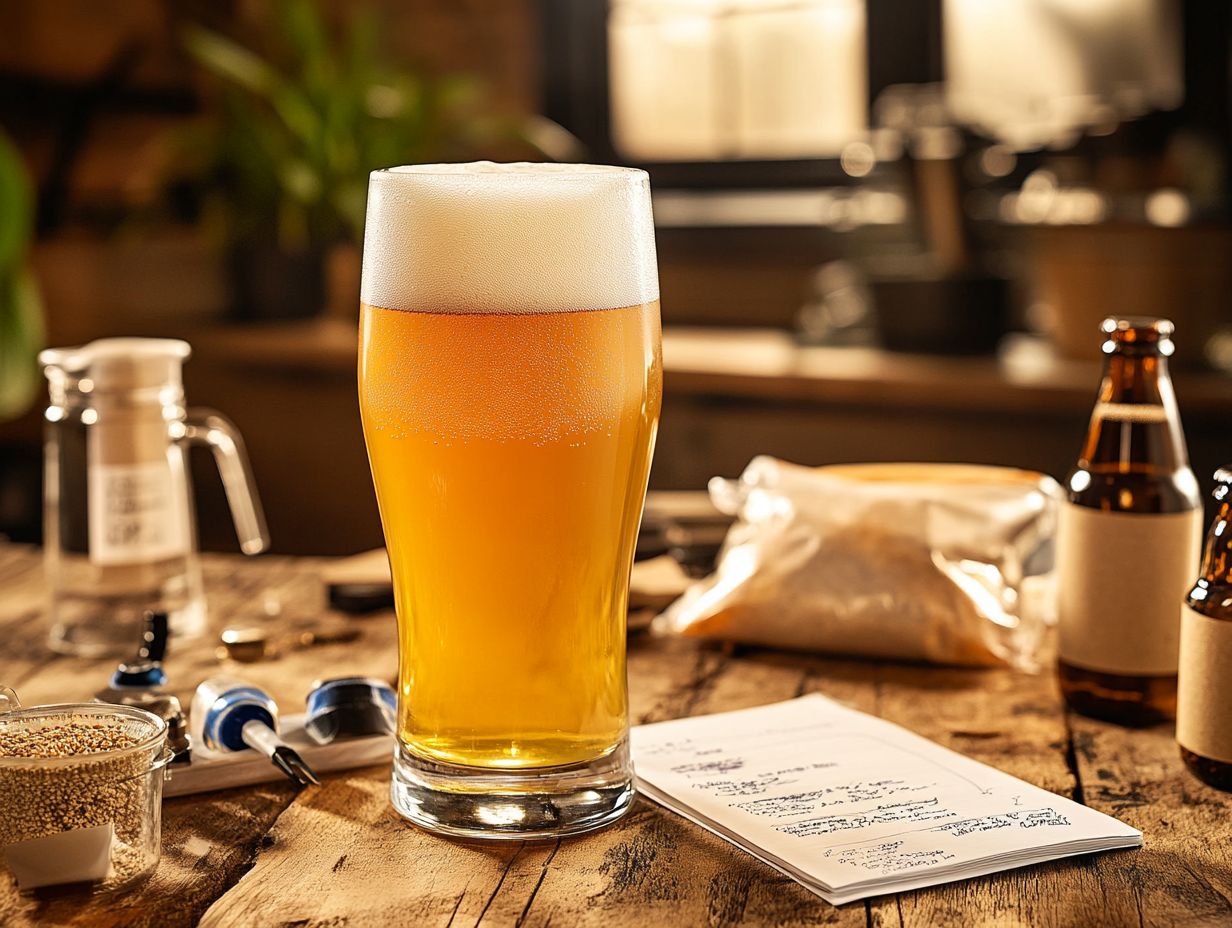
Mastering proper wort boiling techniques is vital for preventing clarity issues. This crucial phase significantly impacts protein coagulation and removal, thereby reducing protein haze and chill haze.
To achieve that coveted clarity, explore various wort boiling methods. Batch sparging promotes better sugar extraction and minimizes haze-forming proteins.
Pay close attention to the timing of your hop additions. This can greatly affect the beer’s final clarity.
For example, adding hops early in the boil enhances both flavor and bitterness, while late additions provide aroma without disrupting the sedimentation of proteins. Understanding late hop additions can significantly impact the final product’s clarity and taste.
By employing these techniques and ensuring a rapid cooling process post-boiling, you can further enhance the clarity of your final product. This effectively allows unwanted compounds to drop out of suspension. This way, you can achieve a crystal clear beer that not only looks good but also tastes good.
3. Proper Fermentation Techniques
Proper fermentation techniques are crucial for achieving clarity and stability in your beer. Those tiny yeast cells significantly impact the overall clarity of the final product. Managing the fermentation process and understanding the behavior of different yeast cells play pivotal roles in this phase.
To enhance this clarity, focus on temperature control during fermentation. Keeping the temperature within an optimal range allows the yeast to perform efficiently, which helps to minimize unwanted byproducts that could cloud your brew.
Selecting specific yeast strains can also shape your beer’s outcome. For example, if you opt for Wyeast 1469, you can expect a cleaner finish; this strain flocculates well (which means they clump together and settle out of the liquid) and settles quickly, reducing haze. Alternatively, if you’re in the mood for crisp and clear lagers, Saflager W34/70 is renowned for its excellent fermentation characteristics that yield a refreshing profile.
Managing these yeast strains effectively considering pitch rates (the number of yeast cells added) and oxygenation ensures that your beer not only undergoes efficient fermentation but also achieves that coveted clarity you’re aiming for. Techniques like secondary fermentation can further help in achieving a clearer final product.
4. Proper Filtration and Fining Techniques
Don t underestimate the power of filtration; it can transform your brew from ordinary to extraordinary! Implementing effective filtration and fining techniques can significantly elevate the clarity and stability of your beer. These processes are crucial for brewers like you, who aim to create visually appealing and consistent beverages. Filtration techniques such as using a carbon filter can make a noticeable difference.
You have a variety of filtration options at your disposal, such as membrane or plate filtration, which effectively remove unwanted particles. Fining agents like gelatin and Polyclar effectively bind to haze-forming proteins and tannins. This enhances the clarity of your brew. If you re looking for a modern twist, using Magicol can provide an innovative approach by specifically targeting certain compounds.
Each of these methods and agents interacts uniquely with your brewing ingredients. This allows you to choose the most suitable option based on the type of beer you’re producing. By carefully selecting and applying these techniques, you can dramatically improve clarity, resulting in a more vibrant and inviting appearance in your final product.
How to Fix Beer Clarity Problems?
Achieving clear beer is essential for many brewers. It enhances appearance and flavor, making your brew more enjoyable.
Fixing beer clarity issues may seem straightforward. However, it requires patience and techniques tailored to each specific problem. Applying the right clarity techniques at the right time is key to resolving many clarity problems.
1. Cold Crashing
Cold crashing is a highly recommended technique for you if you’re dealing with clarity issues in your brew. It effectively encourages yeast and proteins to settle, leading to that beautifully clear beer you desire.
Cold crashing is the process of rapidly lowering the temperature of beer after fermentation. This helps unwanted particles settle out. Utilizing a brew fridge can help you maintain the necessary low temperatures for effective cold crashing.
This process involves lowering the temperature of your fermenting beer to around 32 F to 40 F (0 C to 4 C), usually done once fermentation wraps up. Timing is everything; letting your beer cold crash for about 24 to 48 hours can truly enhance its clarity.
Using mini kegs for storage post-cold crashing can help maintain the clarity you’ve worked hard to achieve. Many in the brewing community rave about how this technique elevates the appearance of your beer and contributes to a smoother flavor profile.
It’s essential to ensure a gradual temperature decrease to prevent shocking the yeast, which can result in some rather undesirable flavors.
Plus, using a transparent fermenter allows you to monitor sedimentation closely and assess how effective your cold crashing process has been.
2. Fining Agents
Fining agents are critical tools in your brewing toolkit, enhancing beer clarity by effectively binding haze-causing particles so they can settle with ease. These agents are an integral part of many brewing styles that prioritize clarity.
Among the most sought-after fining agents are:
- Irish moss: A type of seaweed that shines during the boiling stage, working harmoniously with the proteins that cloud your brew.
- Gelatin: Derived from animal collagen, it is introduced after fermentation, efficiently clarifying a variety of beer types.
- Polyclar: A synthetic marvel that excels at removing tannins and polyphenols, making it particularly suitable for pale ales and lagers.
- Magicol: Known for its modern approach to targeting specific haze-causing compounds.
Understanding the optimal timing and method for utilizing these fining agents can significantly impact not only clarity but also mouthfeel and flavor, enabling you to craft the perfect pint. Using fining agents like Polyclar precisely can enhance overall clarity and stability.
Remember, achieving a perfectly clear beer is within your reach with these techniques, especially when you understand the link between fermentation and beer clarity!
3. Filtration
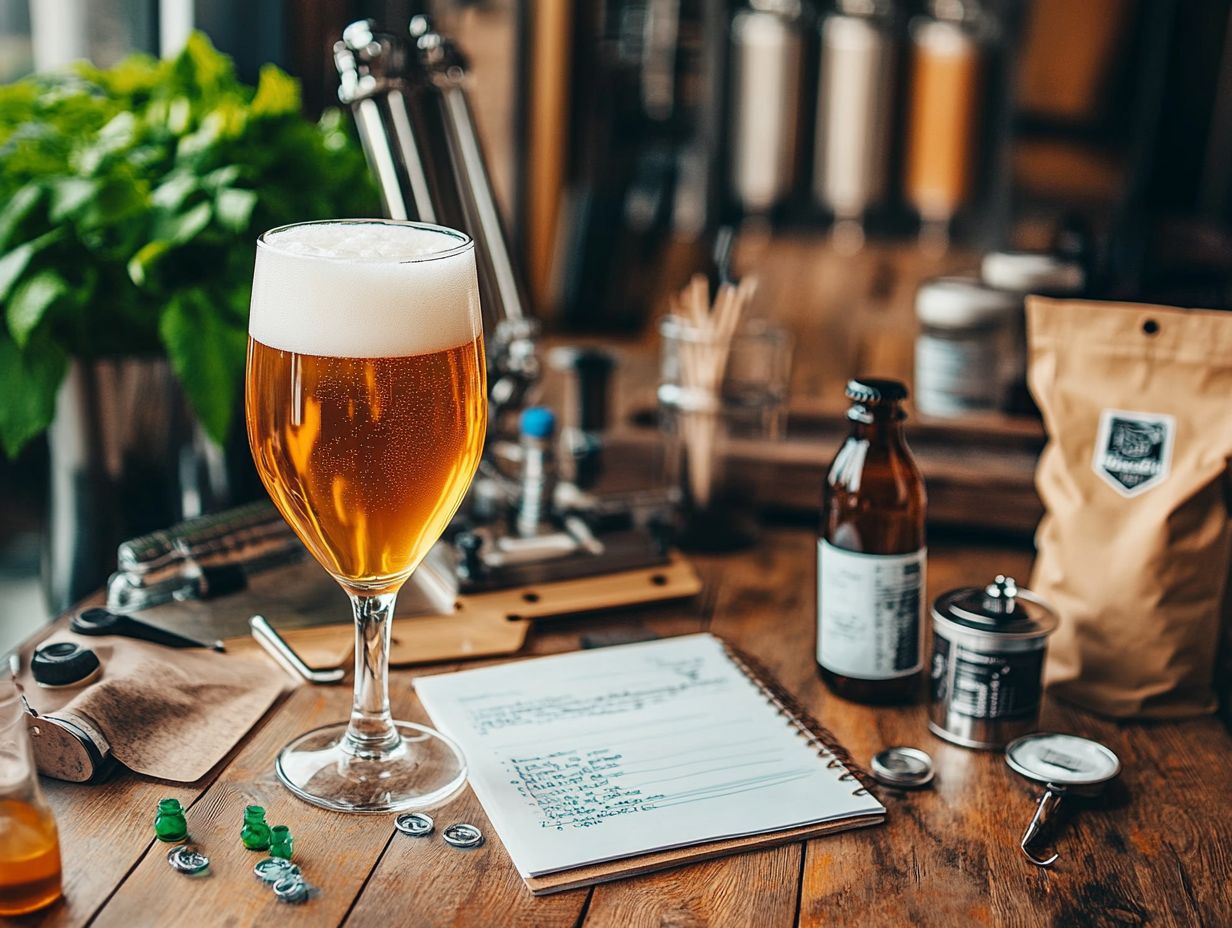
Filtration serves as an effective solution for addressing clarity issues in beer, enabling you to physically eliminate haze-causing particles from your final product. A carbon filter can be particularly helpful in refining the clarity of your brew.
You ll find that brewers often employ a range of filtration techniques to achieve this desired clarity, each offering its own distinct advantages. Mechanical filtration methods, for instance, utilize systems such as plate and frame filters, which consist of tightly woven mesh or paper designed to capture suspended solids.
Alternatively, depth filtration techniques make use of materials like diatomaceous earth or activated charcoal, allowing for more thorough filtration as particles become trapped within the filter medium. Employing a carbon filter can also enhance the clarity by removing finer particulates and improving overall brewing quality.
By incorporating these techniques into your brewing process, you can significantly enhance both the appearance and quality of your beers. The result is a cleaner taste and a visually appealing presentation that resonates with today s discerning consumers.
4. Time and Patience
Sometimes, resolving clarity issues simply requires you to embrace the art of patience throughout the brewing process. Over time, you will gain valuable brewing knowledge that will aid you in achieving the perfect clarity.
As you delve deeper into the world of brewing, you ll discover that great things often come to those who wait, particularly when it comes to achieving that perfect clarity. This waiting period is essential, allowing sediment to naturally settle at the bottom of the vessel, resulting in a cleaner presentation in your glass. Watching sediment settle is a key part of the process, leading to a clearer final product.
A seasoned brewer like yourself understands the significance of this phase and realizes that interference too early can disrupt the beneficial processes in play. By recognizing when to let nature work its magic, you can enhance not only the visual appeal of your beer but also its flavor and overall quality.
This journey in brewing cultivates a more intuitive approach, distinguishing the rush of a hasty batch from the finesse of a well-conditioned masterpiece. Sharing these experiences with fellow enthusiasts at events like the National Homebrew Conference can provide further insights into achieving clarity.
Frequently Asked Questions
What are some common causes of beer clarity problems?
Some common causes of beer clarity problems include improper filtering, improper fining, protein haze, chill haze, or an infection in the beer.
How can I troubleshoot my beer’s clarity issues?
To troubleshoot beer clarity problems, start by checking your brewing equipment to ensure it is clean and free from any contaminants. Next, check the brewing ingredients and brewing process to identify any potential issues. Consider consulting a brewing calculator for more accurate measurements.
Why is my beer hazy or cloudy?
There are several reasons why your beer may be hazy or cloudy, including the presence of yeast cells or proteins in the beer, improper chilling or carbonation, or inadequate filtration. Hazy beer can also result from polarizing hops or the use of certain brewing styles.
What can I do to improve the clarity of my beer?
To improve the clarity of your beer, you can try using clarifying agents such as gelatin, isinglass, protofloc, or polyclar. Additionally, cold crashing the beer before bottling or kegging, using a secondary fermentation vessel, and employing filtration techniques can help.
Can beer clarity problems be fixed?
In most cases, beer clarity problems can be fixed by identifying and addressing the underlying cause. However, there are some cases where the haze or cloudiness in beer may be due to permanent characteristics of the beer, such as high levels of protein, hop sediment, or specific brewing methods used.
How Can I Prevent Beer Clarity Problems in the Future?
Key Strategies for Beer Clarity
To prevent beer clarity problems, maintain a clean and sanitized brewing environment. Use high-quality ingredients and follow proper brewing techniques.
Regularly check your brewing process. For instance, use a filter for your water and keep the right acidity level.
Engaging with the brewing community can provide helpful advice and troubleshooting tips. You can ensure your beer looks great!

